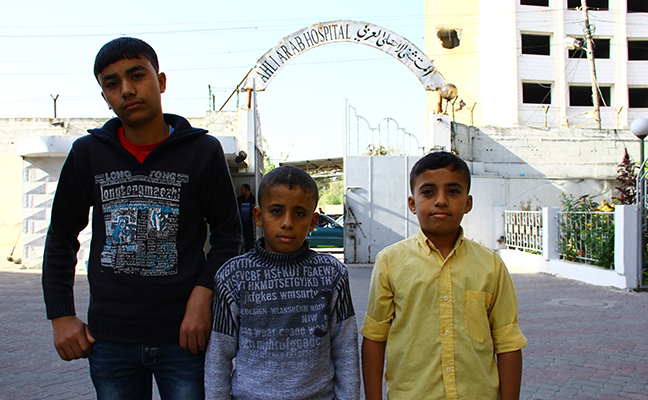A guest blog from associate partners Embrace the Middle East …
Ten-year-old Shadi was preparing breakfast with his family when the missiles hit. Ten members of his family, including his mother, grandmother, aunt and cousins were killed. Shadi was taken to hospital where amidst the chaos, he was presumed dead and placed in a body bag ready to be buried.
It was not the first war Shadi had experienced. Born just before the blockade began, he has already lived through a number of short but intensely violent conflicts. So when the 2014 conflict in Gaza erupted with its terrifying aerial bombardments, his family tried to continue their lives as normally as possible. There was no knowing how long the war would last, and people were saying that since you can’t hide from the missiles, you weren’t any safer staying at home anyway. So one July morning, Shadi and his two older brothers, Alaa and Ahmed, went with their mother to his aunts for breakfast. His father had gone out to look for work.
Alaa, who was thirteen at the time, remembers what happened next. “We were sitting preparing for breakfast. Suddenly the rockets came and smashed all the windows. I lost consciousness after the first explosion, but then I remember hearing the second. A gas cylinder exploded on to Shadi. He had fire all over his body. There was smoke everywhere, and I carried Shadi out of the house. I didn’t even realise I was injured, my right leg had shrapnel in it, and I got an electric shock from the hand rail. Then the third rocket hit as we were leaving the house.” After reaching the street, Shadi and his brothers were taken to the government hospital by bystanders.
Meanwhile their father, Shukri, heard about the bombing on the radio. “I knew it was near the house, so I went there. Outside in the street I saw parts of bodies scattered everywhere, no part was bigger than the size of a hand. My wife and her family were all killed.”
He heard that his three sons had been taken to hospital so he rushed there. To his horror, he found Shadi’s body already wrapped up inside a body bag. He unzipped it to look upon his son. Remarkably, although unconscious and badly injured with burns and blood covering his body, Shadi was still alive.
It’s been a long recovery process. The physical and psychological scars of that day remain. The three boys were transferred, at Shukri’s request, to Embrace’s partner hospital, Al Ahli. The government hospital had been planning to amputate Alaa’s injured leg, but the medical director at Al Ahli was able to perform surgery and skin grafts to save it. Following surgery, Alaa spent one month recovering at the hospital and benefited from the psychological counselling made available for survivors of war. “I feel better now”, he says, “I still need some treatment for my burst ear drum and plastic surgery for my leg; it itches. I just want to recover completely. People at school give me a hard time because Shadi is disfigured by his burns.”
But Shadi, the boy who lived despite being left for dead, is also focused on the future. When I met him he appears shy, letting his older brothers and father do most of the talking, as custom would dictate. But when he speaks, he is quietly assured. “I like school because I like learning” he tells me, “English is my favourite subject.”
Shukri beams with pride over his three sons, and thanks God for their lives. “These three were the only ones who lived” he says. “Now I just want their life to be better than mine.”
At Greenbelt we’ll be asking you to get involved in bringing change to the people of Gaza. Please join us in the G-Source village and find out how you can help Shukri’s hopes for his children become a reality.
Names have been changed
Photo: Three brothers: Alaa, Shadi, Ahmed (L-R)
Photo credit: Charlotte Marshall


